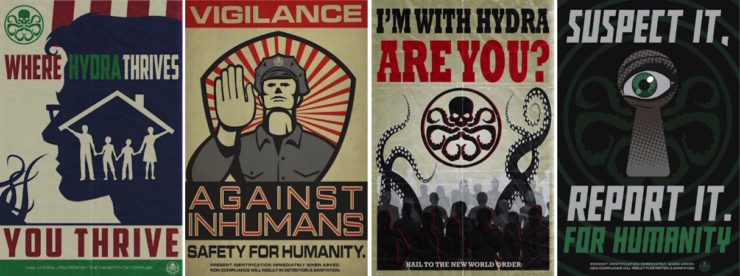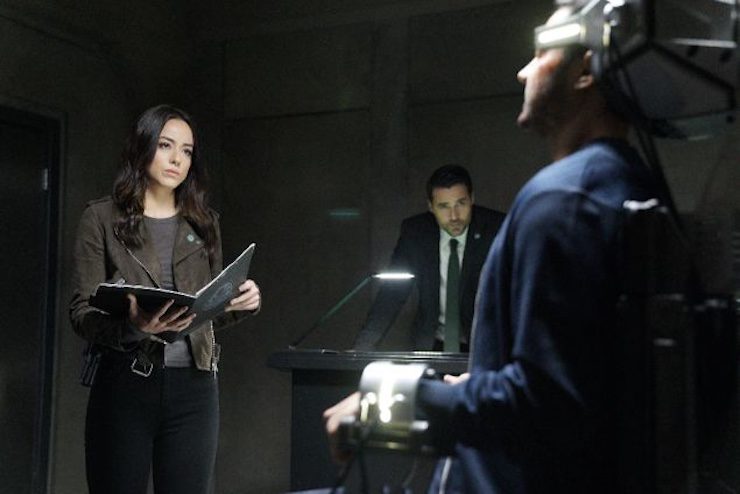Marvel’s Agents of S.H.I.E.L.D. returns for the final part of Season Four, a season divided into three Netflix-able chunks, and this arc has been set up in fine fashion. Life Model Decoy Aida has turned on Radcliffe, her creator. Her fellow LMDs, impersonating Mace, Coulson, Mack, Fitz and May, have taken over S.H.I.E.L.D. HQ. The real agents are strapped down in a former Soviet submarine, their minds trapped in the Framework, an alternate reality where people can live a life in which their greatest regret has been erased.
Only Daisy and Jemma have escaped with a small team aboard the Zephyr, along with the equipment they need to enter the Framework themselves. But what they find is not a world of happiness—instead, it’s a world ruled by the evil Agents of Hydra. The episode is entitled “What if…” and that’s the game the next few episodes will be playing. So let’s swallow the red pill, step through the looking glass, push forward the lever of our time machine, and dive down the rabbit hole into the world of the Framework!
(Spoilers ahead.)
First Things First: Before the new episode even aired, we had a lot of hints about what we would see, beyond what was presented at the end of the last episode. Spoilers had been spilling out all over the internet: Previews showing Grant Ward. A picture of Agent May on Facebook with the caption: “Saving the girl in Bahrain will change everything for Agent May in the Framework.” Images of Hydra motivational posters. Concept art showing Jeff Mace as a resistance fighter against Hydra. Then most recently, and most intriguingly, a picture of Mallory Jansen in the role of Madame Hydra, one of the greatest villains in Marvel comics.
Madame Hydra first appeared in issue 110 of the Captain America comic in 1969. She was created by Jim Steranko, the artist drawing that issue. He brought to his short run on Cap the same vivid action, unusual viewpoints, and surreal images that characterized his days on the Agents of S.H.I.E.L.D. comic book. The two page “splash page” in the middle of that issue, where Cap launches himself headlong into the forces of Hydra, is one of the greatest images in comic book history. And I remember Madame Hydra immediately grabbing my 14-year-old attention as I read that book. In a skin-tight green body suit and opera gloves, with spike heels, black hair covering much of her face, a pistol on each hip, and a whip in her hand, she was like an evil doppelganger of Wonder Woman. She was a character who attracted and intimidated at the same time, an intriguing combination to a young comic reader. Over the years, she proved to be a worthy opponent of both the Avengers and S.H.I.E.L.D. And as Aida is the driving force behind the Framework, with powers that might even seem god-like to those it contains, it will be interesting to see how Madame Hydra plays into this storyline.
Playing the game of “what if?” has a long history in fiction. Whether the protagonist travels to a distant land, goes forward or backward in time, or even sideways in time to an alternate reality, authors have long delighted in examining a version of the world in which things worked out differently. Of course, there’s an entire sub-genre of science fiction, “alternate history,” devoted to this practice. Television and movies are no exception: Agents of S.H.I.E.L.D. joins a long tradition of TV shows that have spent at least an episode or two looking at what would happen to their characters in a different world. One of the most famous examples is the “Mirror Universe” of Star Trek, which became one of the most popular episodes of the original series, and spawned additional adventures in Deep Space Nine, Star Trek: Enterprise, novels, comics and video games. Only a couple of weeks ago, though, we saw Supergirl and the Flash in a crossover episode that took place in an altered version of reality in which the characters all broke into song and dance numbers. These episodes can be great fun, but they can also run the risk of becoming “jumping the shark” moments, where the creators twist the show’s established reality just a bit too far. As the Framework plotline spins out over the next few weeks, it will be interesting to see if this story succeeds.
Episode 416, “What If…”
The pre-show synopsis from ABC tells us, “Hail the New World Order! Daisy and Simmons uncover secrets and lies in a world gone mad. With Hydra in control, they are our only hope to save everyone.”
The show opens with Daisy’s realization that she is in a relationship with Grant Ward, as she wakes up next to him and they head off to work. They commute from downtown DC to the Triskelon in Arlington (which proves the Framework is definitely a different world, because who commutes out of DC?) The offices are grim, the tech is different (fingerprints replacing computer passwords), and there are motivational pictures everywhere explaining the dangers of Inhumans. This version of Hydra obviously hasn’t brought Hive home from the far-away planet, or they would have those pesky Inhumans under control. Daisy meets May, who is all business, and has no idea what Daisy is talking about when she mentions the Framework. Daisy realizes that this rescue mission could be harder than she thought.
Meanwhile, Jemma awakens to find herself in a shallow grave alongside a badly decomposed body, and signs that she took two slugs to the chest; it appears that in the Framework, she was murdered in some sort of mass attack at the old S.H.I.E.L.D. Academy. She gets a ride from a good Samaritan who freaks out when they reach an Inhuman screening checkpoint—she sees that Jemma’s ID is S.H.I.E.L.D. and forces her out of the car. Ward and “Skye” are sent to interrogate a man who Daisy recognizes as Vijay Nadeer, and Ward surprises her by punching him. Jemma tries to blend into the crowd at a coffee shop, but two agents pick her up, and she has to zap both of them with some sort of cross between S.H.I.E.L.D.’s icer guns and a taser—another example of slightly different tech. Coulson is teaching a high school class, talking about how beneficial Hydra has been since the “Cambridge Incident.” He talks about how any links between Hydra and Nazis are simply propaganda, and about the dangers of a free press. A kid is led out of the classroom by Hydra agents, and Coulson puts up no resistance.
May comes in to the interrogation room, and Vijay taunts her for making the wrong call in Bahrain. She sends him with Daisy to “The Doctor.” In the real world, May killed a kid and saved the world; here she saved a kid, and destroyed the world—no wonder she is so testy and focused on business. Vijay attempts to escape and we see that the infamous Doctor is Fitz. We can tell he is infamous because he has ominous background music. Jemma takes the agent’s car, goes to the park bench that is her and Daisy’s rendezvous site, and finds the cell phone that will allow them to escape the framework, but Daisy is nowhere to be seen. Jemma then goes to visit Coulson, but he also doesn’t recognize her. No one remembers their real life. She finds his hula girl statue and tries to use it and the “magical place” phrase to trigger his memory, but as soon as she leaves he calls to report a subversive.
Jemma finds a kid spray painting her car, and accuses him of being a “rogue piece of code.” She is having trouble believing that the Framework is real. He helps her by loaning her his car (another sign that this is not the real world, as what kid would give up his ride to a stranger?), but a drone has been watching. Fitz examines Vijay with a device that tortures him at the same time, something Daisy has trouble accepting. May interrupts with the news that a man named Coulson has reported subversive activity; they dismiss Daisy, and Fitz tells her to handle it. Ward is wondering what is wrong with Skye—her atypical behavior is more and more obvious. Coulson goes through his files at work, finding more and more items that trigger odd feelings and memories. Skye goes to the park bench, and she and Jemma finally meet, but Ward confronts them with a gun, and says, “We need to talk.”
Acting on the report from Coulson, however, Hydra agents are closing in, and Ward shoots one of them—it turns out he is connected to “The Resistance.” I kind of saw that coming. After all, if he was a turncoat against S.H.I.E.L.D. in the real world, wouldn’t he be a turncoat against Hydra in the Framework? A car chase ensues, and they trade shots with black Hydra SUVs. Ward admits that he has been covering for Skye and knows that she is an Inhuman. They have to leave the car, because “the drones” are coming; Ward gets ready to torch their car, and says he will see them soon. Back at HQ, May briefs Fitz on the escape of the mysterious subversives, and shows him a forged ID Vijay had been using, which indicates a mole inside Hydra. They discuss how cameras must have recorded the incident, with the images sent straight to “The Director.”
Daisy and Jemma are trying to figure out how the Framework is so profoundly twisted and evil—it’s not only a way of keeping prisoners occupied, it has become an end unto itself. They try to leave the Framework, but their device does not work. Fitz goes to the Director, who is Aida—she’s not namechecked as Madame Hydra yet, but she is dressed all in green (albeit a more conservative outfit than the Madam Hydra of the comics). She tells him that she has eliminated the loophole the enemy would have used to escape—she clearly has some level of control over what happens in the Framework. And it turns out that Fitz and Aida are in a relationship, which helps explain why Fitz has turned bad—he is lost without the love of a good woman.
In the stinger, Coulson goes to his car and finds Daisy in the back seat. She wants him to remember, but all she is doing is torturing him…but then she tells Coulson that he’s the closest thing she has to family, and after a long pause, he calls her Daisy.
In the trailer for the next episode, Coulson and Daisy are captured by the Resistance, which is apparently led by Jeff Mace. There is turmoil at Hydra HQ. Radcliffe appears, and doesn’t offer much hope to our beleaguered agents.
Final Thoughts
The new arc is off to a really good start. Seeing how things are different or the same between the real and Framework worlds is a fascinating game. People have the same inclinations, but different experiences have shaped them in different ways. The little differences in technology are also clever. I think that the total ascendance of Hydra, and suspension of civil rights, is a bit doubtful in such a short period of time. But I suppose it is possible, with the Cambridge Incident providing an excuse for Hydra to take root in the way the Reichstag fire of 1933 gave the Nazis an excuse to take more power. There are more characters to meet in the next episode, and more worldbuilding to do, so the storyline definitely has my attention, and the powers that Aida has over the Framework ups the stakes and increases the level of jeopardy, keeping viewers on the edge of their seats.
So let’s start the discussion. If you have been reading these reviews, you know the drill: this post will kick off a discussion thread I will shepherd as the third portion of the season unfolds. If you want to follow the discussion, the best way is to use a Tor.com user account. If you don’t have one, it’s easy to sign up. Then you can follow the thread using the “My Conversations” feature, which makes it a lot easier to participate in discussions on the website. Feel free to come back each week and discuss the latest episodes, or whatever S.H.I.E.L.D. developments you might hear about. In the words of the uncanny Stan Lee, “Don’t yield, back S.H.I.E.L.D.!”
Alan Brown has been a fan of S.H.I.E.L.D. from its comic book beginning over fifty years ago. He still remembers reading that very first adventure in Strange Tales #135.













